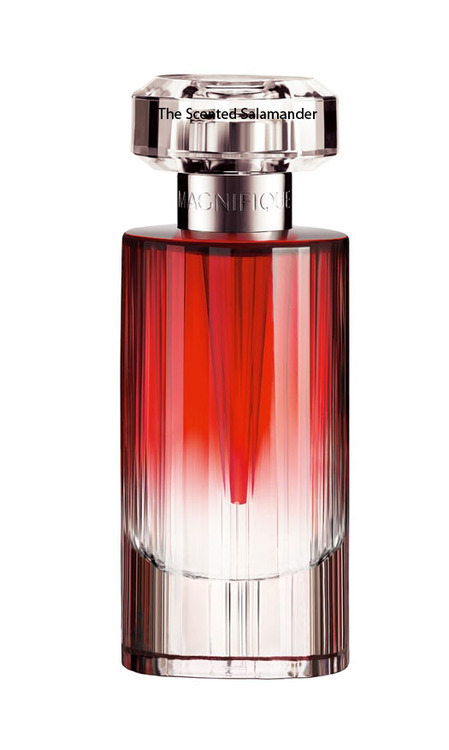Lancôme Magnifique (2008) {Perfume Review} {New Fragrance}

Magnifique (Magnificent) is the latest major feminine fragrance launch by Lancôme, and as its name indicates it wishes to come across as one of those pedestal-scents that are meant to act as the sublime allies of glamazons. The lovely Anne Hathaway is its idealized incarnation. A deep red highlighted by black was chosen as a color-theme meant, no doubt, to celebrate feminine passion. A dedicated micro-website will launch in 14 days.
The Nagarmotha Touch
A combination of hyper-classic rose - Lancôme's iconic flower - and an exotic grass known under many names, one of them being "Nagarmota" (as in the press release) was devised to create a perfume obviously at once very establishment and in quest of new sensations. It suggests the story of a genteel European lady having decided to escape the confines of her countryside manor and the stifling boredom of a life constrained by too many conventions and rules, and burdened by infinite leisure time. At the same time, she is somewhat paradoxically on a budget.
Reportedly having traveled to India in quest of unusual exotic scents, tandem of perfumers Olivier Cresp and Jacques Cavallier finally decided to incorporate the central woody-grassy note also known as Cypriol, Umbrella's Edge, Bois de Papyrus or essence de cypérol or more esoterically still in Sanskrit, Bhadramusta.
Virtually each Indian language of the subcontinent has a different appellation for it. Its Latin name is Cyperius Scariosus R. Br. If my cross comparisons of the different terminologies used are accurate, it was featured previously in several designer men's fragrances: Xeryus by Givenchy (1983), Gucci pour Homme (2003), L'Eau d'Issey pour Homme Intense (also by Jacques Cavallier) and more recently Tom Ford for Men which prefers to reference it as "Cypriol". The latter used the note for a vegetal-musk effect rather than for its woody facet as in Magnifique...


Anne Hathaway at a photo op for her latest movie, Get Smart with actors Dwayne Johnson, Steve Carrell © Mike Marsland
Perfumer Bertrand Duchaufour likes this material as well as it appears in Timbuktu and Dzongkha. Come to think of it, might also be in the upcoming Fleur de Liane as well described as the "beaten-fiber" grassy effect noted earlier in my review of it. Annick Goutal Musc Nomade also resorted to Nagarmotha under the names Bois de Papyrus and Bombay Wood in French and English respectively, also for its non-animalic musky effect.
This particular musky dimension was noted by writer Maurice Magre in his book, Le poison de Goa (The Poison of Goa) (1928) in which he wrote evocatively that,
"Du vin avait été récemment répandu et son odeur se mêlait à celle du tabac et à
cette odeur de musc que dégagent les vieilles maisons de bois de Bombay"
"Wine had been spilled recently and its smell mingled with that of tobacco and the smell of musk that comes from the old houses made of Bombay wood."
Despite the fact that perfumer Jacques Cavallier thinks that Nagarmotha was not showcased before in a feminine perfume prior to Magnifique (he told WWD, "As far as I know, it's never been used before in feminine fragrance,"), it is part of the feminine perfume Rose Kashmirie by Les Parfums de Rosine which is also inspired by India; it was issued last fall and in it the nagarmotha is blended together with a spicy saffron note, which incidentally, is also featured in Magnifique but for a different effect overall.
We can understand the meaning of Cavallier's remark to really be: never smelled before in a feminine fragrance as in the mainstream luxury market as opposed to the unpredictable eccentric and idiosyncratic notes of the small perfume houses which do not count in the big-picture thinking of professional perfumers working for large corporations - Firmenich in this case - or at least in official press junkets.
Magnifique From Top To Bottom
Perfumes are, like movies, essentially works of illusion. Just like films, some resist rewinding and repeated viewings better than others still continuing to mesmerize or at least charm spectators thanks to the substance they contain in them while others let out some little technical defects that call attention to the workings of the scent rather than keep your mind focused on visions.
When smelling Magnifique you can decide to either just go with the flow and enjoy the perfume or start noticing the nuts and bolts of it. In the first case, the overall impression will be that the rose makes a magnificent entrance, blooms, then takes on an unusual exotic scent and finally envelops you like a warm cashmere shawl. In the second case, you might notice that the base animalic notes (musk, amber) in particular are not authentic or rich enough to come across as truly "magnifiques".
It is not always a good idea to judge modern perfumes by the standards of vintage ones - and in fact, I try avoiding to do so normally - but when reflecting upon what makes a perfume be felt to be larger than life or flamboyant, it is hard to escape the notion that the drydown ought ideally to reveal special depth and presence and diffuse a lasting aura. The vibrancy that marked animalic notes can bring to a fragrance, helps attain this goal. The deeper woody notes used in Magnifique, in their turn, which were felt to be a calculated risk for a mainstream audience - read, the mean of schematic average tastes that no one posesses individually - were lightened rather than darkened or made to be animalic, to make the bet safer.
The Nagarmotha, a member of the papyrus family, having a hay-like, paper-like facet, this was brought out to recreate a "blond-wood" effect, in my view, with a complex spicy overtone nevertheless. In other words, the woods were visibly made to be more feminine, softer, less trenchant, and the rose made fruity and a bit candied to counterbalance the felt risk,
"The challenge was to work on wood [notes]," said Cresp, explaining the women's fragrance market has few woody juices. While he and Cavallier were in India they came upon nagarmota, a plant giving off a woody odor. They liked it so much, they opted to use nagarmota essential oil in Magnifique." (cf. WWD)
Cresp also explained that they were interested in the light--and-shadow effect of Nagarmotha.
Magnifique opens on a very rosy, rhum-y, spicy and fruity rose with tangy and woody touches and a little salty edge. The May rose absolute is quite perceptible weaving its motif with a light, non-indolic jasmine Sambac, the latter also emphasizing an impression of lower risk threshold from an olfactory viewpoint. After the initial rather sublime entrance of the rose, the perfume soon goes into a soft mode becoming subtly creamy. Despite the dark, saturated colors of the Magnifique bottle and advertisement, meant to celebrate red, the creamy woody impression evokes an ivory satin gown. The color red is added with touches of red fruits.Then the scent starts revealing a citrusy lift (geranium, often used paired with rose), more luminosity, and an exotic smell arises which seems to be a combination of papyrus with berries and little touches of hard (sharp aldehydes) fruit sours, but done in a sophisticated manner. The scent is slightly peppery to reinforce its main spicy facet resting on saffron. Echoing the rhum-y nuance, a Vodka-like facet seems to be present, probably linked to the rose essences.
On one level, the blend is unusual, deliciously woody and creamy and distinctive. On another, more commercial and pedestrian notes surface.
Nagarmotha is traditionally used to scent saris, and there is something luxurious about the perfume that calls to mind the silken folds and rustle of a richly embroidered sari.
There is a "creamy banana" effect to the softness of woods that is noticeable. A touch of pastry-like vanilla cream also further adds a gourmand association.
The Nagarmotha which was used in Tom Ford for Men for its musky smell has been used here for its exotic aromatic and plant-like facets.
There is a little woody camphoraceous edge, very reminiscent of South Asia, that makes the scent seem to be a little bit more challenging than expected for a designer perfume, counterbalanced by much "easier" candied fruity notes. Olivier Cresp is also known for adding a signature lucky gourmand accord in his perfumes since Angel by Thierry Mugler (cf. Dolce & Gabanna Light Blue, Nina by Nina Ricci, Elle by Yves Saint Laurent...)
As the perfume unfolds, a smokier facet appears mixed with the spiciness of sandalwood, continuing to rest on a slightly tangy, creamy fruity-floral background, with the Nagarmotha conferring its distinctive signature to the blend. There seems to be a touch of jammy pineapple as well.
After testing it several times, a deep kinship to classic fruity chypres like Guerlain Mitsouko and Rochas Femme (the latter was actually reformulated by Olivier Cresp in 1989) appears, even perceptible in a stewed-peach undertone, but with the addition of lactic, milky woods.
As the woods develop, they become richly exotic bespeaking of Indian summer nights, with a slight swirl of smoky incense to them. The smokiness is perceptibly due to vetiver. Nagarmotha is also reported to have a Frankincense facet in some cases.
The perfume slowly turns into a skin scent, a complex blend of spices and creamy woods with hints of resins and if there is some sillage, it is not the rope-like, several-feet-long kind. The drydown evolves overtime with the Nagarmotha grass becoming more and more papyrus-like and blond.
Magnifique, like many other works by esteemed tandem of perfumers Olivier Cresp and Jacques Cavallier, is an exercise in balancing out innovative elements with more commercial ones. Without being conservative or drab, their professional perfumery usually aims to reach a, hopefully, satisfactory equilibrium between well-tested olfactory trends and less well-tested waters. Of course since both men have been creating perfumes for decades these parameters are particularly well-internalized and do not come across as feeling mechanical but rather as springing from personal conviction that this is the way to satisfy and please a great number of perfume wearers.
In the end, Magnifique, all reservations set aside, will probably be perceived as a lovely feminine and elegant perfume that is easy to wear. It is an exotic perfume but this exoticism is contained within an European tradition of perfumery that refuses excess, only urbanely alluding to it: the raw silk of India has been imported and tamed on Western looms.
It is also a kind of perfumery that is happier being an accessory to feminine beauty than in search of independent affirmation. What kind of perfume are you looking for today?
Top: Spicy saffron
Heart: Mai de Grasse rose absolute, Bulgarian rose essence and Sambac jasmine.
Base: Nagarmota essence, vetiver, sandalwood essence.
"Availability
Lancôme's Magnifique will be available in September 2008 at Lancôme counters in fine department and specialty stores nationwide [it is actually available now], the five Lancôme boutiques and at www.lancome-usa.com.
Suggested Retail Prices
1.7 oz. Eau de Parfum $65.00
2.5 oz. Eau de Parfum $85.00
6.7 oz. Body Lotion $46.00
6.7 oz. Shower Gel $46.00"
Picture and some information via Lancôme press release









